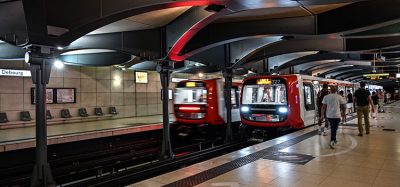Controlling cost overruns on rail projects: a European perspective
- Like
- Digg
- Del
- Tumblr
- VKontakte
- Buffer
- Love This
- Odnoklassniki
- Meneame
- Blogger
- Amazon
- Yahoo Mail
- Gmail
- AOL
- Newsvine
- HackerNews
- Evernote
- MySpace
- Mail.ru
- Viadeo
- Line
- Comments
- Yummly
- SMS
- Viber
- Telegram
- Subscribe
- Skype
- Facebook Messenger
- Kakao
- LiveJournal
- Yammer
- Edgar
- Fintel
- Mix
- Instapaper
- Copy Link
Posted: 30 June 2009 | Professor Matti Siemiatycki, Transportation Policy & Planning Specialist, University of Toronto | No comments yet
Across Europe and around the world, media headlines report a now familiar story. ‘Tube repairs at risk as cost overrun hits £750m’1. ‘Amsterdam Metro Line Sinks Deeper into Trouble’2. ‘Trenton: Rail Construction Faces Cost Overruns’3. And in the most recent setback for the Edinburgh tram project, ‘Tram line design months late as budget slips £10m off track’4. While these media headlines may cover one-off projects, each with their own unique local circumstances that led to escalating costs, there is a growing body of evidence that overruns are a persistent feature of large urban and intercity rail projects. Understanding the patterns and causes of cost overruns is central to developing effective remedies.
Across Europe and around the world, media headlines report a now familiar story. ‘Tube repairs at risk as cost overrun hits £750m’1. ‘Amsterdam Metro Line Sinks Deeper into Trouble’2. ‘Trenton: Rail Construction Faces Cost Overruns’3. And in the most recent setback for the Edinburgh tram project, ‘Tram line design months late as budget slips £10m off track’4. While these media headlines may cover one-off projects, each with their own unique local circumstances that led to escalating costs, there is a growing body of evidence that overruns are a persistent feature of large urban and intercity rail projects. Understanding the patterns and causes of cost overruns is central to developing effective remedies.
Across Europe and around the world, media headlines report a now familiar story. ‘Tube repairs at risk as cost overrun hits £750m’1. ‘Amsterdam Metro Line Sinks Deeper into Trouble’2. ‘Trenton: Rail Construction Faces Cost Overruns’3. And in the most recent setback for the Edinburgh tram project, ‘Tram line design months late as budget slips £10m off track’4. While these media headlines may cover one-off projects, each with their own unique local circumstances that led to escalating costs, there is a growing body of evidence that overruns are a persistent feature of large urban and intercity rail projects. Understanding the patterns and causes of cost overruns is central to developing effective remedies.
Patterns of cost overruns
Over the past half century, more than 20 academic studies and government audits have measured the prevalence of escalating costs on large transport projects. Nearly all of the studies come to the same conclusion: cost overruns are a common part of delivering all types of large road, railway, bridge and tunnel projects, which can have initial price tags of hundreds of millions and even billions of pounds.
The most robust and frequently cited global study of transport project cost overruns comes from research by Oxford University Professor Bent Flyvbjerg. Using an international dataset covering 258 projects in 20 countries, Flyvbjerg and his colleagues found that nine out of ten transportation projects experienced actual costs that were above their initial estimate at the time the decision to build was made5. After adjusting for inflation, the average cost overrun for all types of transport projects was 28%.
Within the sample, rail projects had the largest average cost overrun at 45%, followed by bridges and tunnels at 32%, and roads at 20%. Breaking down the figures further shows that there are wide geographic variations in the average cost overrun for rail projects. European rail project planners have performed better than their global counterparts in controlling delivery costs. The average cost overrun on European rail projects was 34%, compared with 40% in North America and 65% in the rest of the world (see Table 1).
To be certain, not all rail projects experience cost escalations, especially in Europe. In a 2004 report, the National Audit Office documented that six of the first seven urban light rail projects in Britain were constructed on budget. And the multi-billion dollar Paris South-East and Paris Atlantique lines of the French TGV system also avoided significant escalating costs.
Nevertheless, while cost overruns on European rail projects are smaller than in other parts of the world, they remain significantly present. This has led some analysts to argue that underestimating project development costs is just part of the standard planning process for any large infrastructure project, necessary to attract the political and public support needed to get an initiative started. However, such arguments overlook three major problems with cost overruns which can jeapordise the success of rail investments.
Firstly, escalating costs can add hundreds of millions and even billions of dollars to the price of a project, stressing public sector budgets unexpectedly, or severely cutting into corporate profits when projects are delivered through private-public partnerships.
Secondly, escalating costs during the development process may lead to a project’s scope being reduced or later phases of the project being cancelled as funding availability is tapped out. In both Amsterdam and Edinburgh, for example, discussions have taken place about scaling back the scope of ongoing urban rail projects amidst reports of rising costs. Yet the effectiveness of the project to attract new travelers and thus deliver on its broad social benefits may be dependent on the entire system being built and integrated into the existing transport system as initially proposed.
Thirdly, the emergence of a general perception that rail projects are prone to widespread cost overruns could erode public support for such projects, despite the significant economic, environmental, and social benefits that high-performing rail projects can deliver. With public support weakened, rail projects may be passed over for other types of transportation investments where costs are seen to be more certain.
Clearly none of these challenges are unique to rail projects. However, as the sector with the largest recorded average cost overruns, rail projects risk being tarred with the broadest brush. To avoid the negative stereotype, the issue of cost controls requires particular attention from the rail transport industry as a whole.
What causes rail cost overruns?
Cost overruns on large rail projects have a diversity of interrelated causes. The most common explanations relate to the technical challenges of forecasting an uncertain risky future, and difficulties delivering large complex projects, which lead to genuine errors. First, forecasting models often inadequately capture sudden changes in material costs, regulatory environments, or worse than expected construction conditions. Poor forecasting models may be exacerbated by incomplete data which reduces the accuracy of cost estimates. And expedited project planning processes can lead to schemes being approved with incomplete designs or cost estimates, which ultimately result in rising costs as more detailed studies are carried out.
Secondly, for engineers and project managers, changes to a rail project’s scope during detailed project design or construction are identified as another key technical driver of escalating costs. During the construction of a light rail extension in the American city of St. Louis, for instance, 1,636 change orders were requested totalling approximately $147 million, which contributed to a 25% cost escalation over the original project budget.
Thirdly, government auditors from Europe and North America have recognised shortcomings in the accountability systems in place to monitor contractor performance, and share information with respect to cost overruns on past projects. In particular, there is often a lack of ‘intelligent buyer’ skills such as formalised mechanisms to collect, track, disseminate and integrate project performance data into future planning and contractor selection processes.
While there is little doubt that technical challenges predicting an uncertain future are a source of underestimated project costs, technical forecasting and engineering errors alone do not explain the persistence of cost overruns on large rail projects. Rather as Harvard University professors Alan Altshuler and David Luberoff write in their book2:
‘It is striking that this long-standing pattern [of cost overruns], which appears to prevail worldwide, continues unabated despite major improvements in the technical capacity for cost estimation – suggesting that its causes lie primarily in the realm of politics rather than those of engineering or accounting’6.
The political explanations for the persistent pattern of cost overruns on large rail projects, just like on other types of transportation investments, straddle what can be a fine line between error and deception. Early political commitments, support from key community champions, and spending on expensive preliminary studies may ‘lock in’ decisions to support a specific initiative, even as project costs escalate. As Flyvbjerg and his colleagues conclude, ‘cost estimates used in public debates, media coverage, and decision making for transportation infrastructure development are highly, systematically, and significantly deceptive’7.
Additionally, when the capital costs of big rail schemes are funded to a large extent by senior levels of government, there may be immense pressure on local promoters to produce unrealistically low initial cost estimates in order to attract support over projects in other competing jurisdictions. In Toronto, for example, the City Auditor concluded that local project staff working on plans for a provincially funded subway extension had been ‘overly optimistic’ in their cost estimates in order to ‘accommodate a perceived acceptable level of expenditure’8.
Lastly, individuals face immense psychological and organisational pressures to produce underestimated cost forecasts. In their groundbreaking Harvard Business Review article, Dan Lovallo and Nobel Lauriat Daniel Khanneman argue that most people are highly optimistic about their own talents and abilities to control external situations, while underestimating the likelihood of random events or external risks. Conversely, within organisations pessimistic views about a project are often seen as disloyalty, and therefore suppressed as much as possible. The net result is that organisations tend to produce forecasts that are overly optimistic, underestimating project costs and risks while overestimating the benefits.
Redressing cost overruns
In response to growing evidence about the patterns and causes of cost overruns, around the world innovative strategies are being developed to improve the accuracy of rail forecasts, and enhance cost certainty once construction begins.
Improved forecasting techniques top the list of approaches to reduce the frequency of unexpected cost escalations. In the United States, the American Planning Association recently endorsed a new model of cost estimation known as ‘reference class forecasting.’ In this approach, the estimated costs of a project under review are benchmarked against a representative baseline of recently completed projects, as a way of better assessing probable costs and overrun magnitudes.
Keeping with the idea of benchmarking, the British Department for Transport has provided guidance on applying ‘optimism uplifts’ to transportation cost estimates, which are based on past experiences with the scale of underestimation in a particular sector. For metros, urban light rail, and interurban rail schemes, if project planners decide that they want to be 80% certain that the project under review will remain within budget, the Department for Transport advises applying a 57% ‘uplift’ to the approval stage cost estimate9.
Greater project monitoring, reporting and information sharing have been identified as another strategy to reduce cost overruns. One approach that has recently gained international interest is linking a company’s past performance on government contracts with prequalification that gives the firm an elevated chance of obtaining future work. By rewarding high quality outputs, such systems provide a connection between a firm’s current and future interests, and create a transparent incentive to deliver projects that meet their initial estimates.
Finally, emerging relationships between the public and private sector have been another approach to controlling project costs. Private-public partnerships that bundle facility design, construction, financing, operation and maintenance into a single long term concession have become popular as a way of raising funds for rail projects and transferring risks for cost overruns to the private sector.
To date, evidence is mixed about the success of private-public partnerships to successfully transfer cost risks to the private sector. Numerous projects delivered through private-public partnerships have been built to budget. However, the collapse of the London Underground maintenance contract amidst massive cost overruns and the nationalisation of the Croydon Tramlink which unexpectedly cost taxpayers nearly £100 million, raise serious questions about the long-term sustainability of this project delivery model.
Reflecting on the diverse causes of escalating project costs in the transport sector, it is unlikely that overruns will ever be entirely eliminated from infrastructure project delivery. The risks of unexpected events are all too prevalent, the politics of transport planning too deeply embedded and complex.
Nevertheless, for the rail industry, implementing strategies to control escalating project delivery costs is an utmost priority. Reducing the frequency and size of cost overruns provides a significant way of improving project value for money, and can enhance public support for a sector that delivers great community benefits when projects achieve their forecasted expectations.
References
- The Guardian, 2007
- Spiegel Online International, 2009
- The New York Times, 2002
- Scotsman newspaper, 2009
- Flyvbjerg, B., Holm, M. and Buhl, S. (2002). Underestimating Costs in Public Works Projects: Error or Lie? Journal of the American Planning Association, 68(3), pp. 279-295.
- Altshuler, A. and Luberoff, D. (2003) Mega-Projects: The Changing Politics of Urban Public Investments. Washington D.C.: Brookings Institute Press. p. 221.
- Flyvbjerg, B. Holm, M. and Buhl, S. (2002), p. 290.
- Toronto City Auditor. (1998). Sheppard Subway Project Cost Overruns. Toronto: City Auditor. p. 3.
- See the British Department for Transport’s Procedures for Dealing with Optimism Bias in Transport Planning at: http://www.dft.gov.uk/


Related topics
Business Models, Fleet Management & Maintenance
Issue
Issue 3 2009








